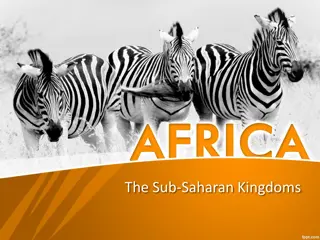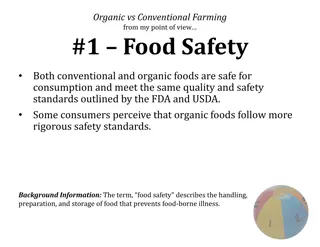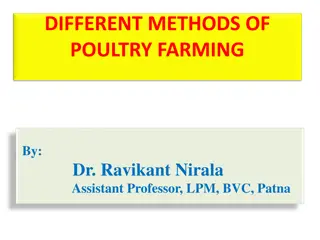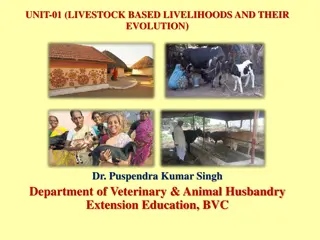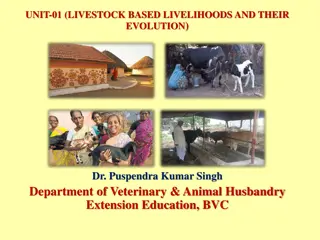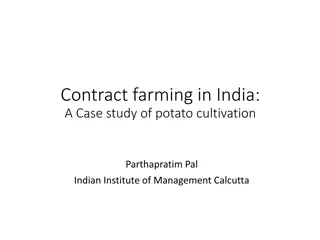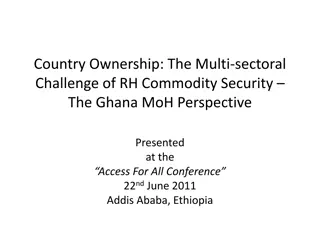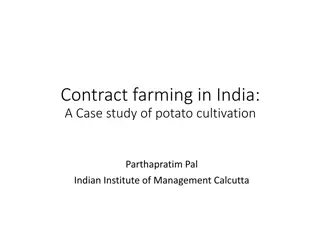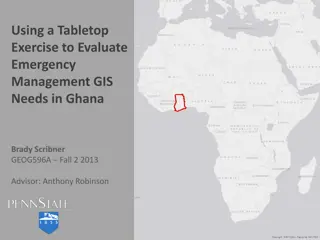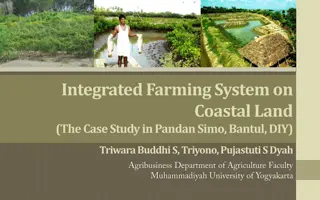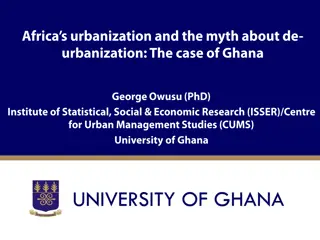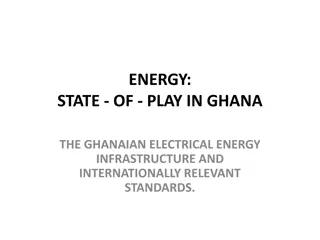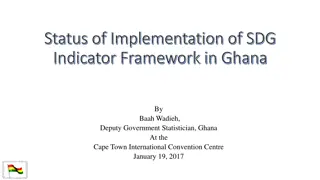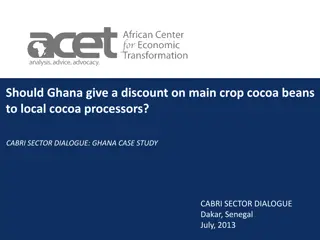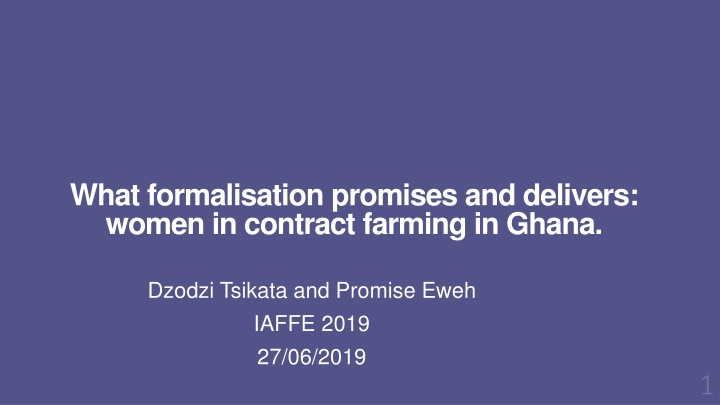
Women in Contract Farming in Ghana: A Study on Formalisation Impact
This study delves into the promises and realities of formalisation for women engaged in contract farming in Ghana. It explores the economic and labour market context, highlighting the predominance of women in agriculture and the implications of formalisation efforts on their livelihoods. The presentation outlines the challenges and opportunities in regulating contract farming and domestic trading, providing insights into the macroeconomic landscape and gender segmentation of work in Ghana.
Download Presentation

Please find below an Image/Link to download the presentation.
The content on the website is provided AS IS for your information and personal use only. It may not be sold, licensed, or shared on other websites without obtaining consent from the author. If you encounter any issues during the download, it is possible that the publisher has removed the file from their server.
You are allowed to download the files provided on this website for personal or commercial use, subject to the condition that they are used lawfully. All files are the property of their respective owners.
The content on the website is provided AS IS for your information and personal use only. It may not be sold, licensed, or shared on other websites without obtaining consent from the author.
E N D
Presentation Transcript
What formalisation promises and delivers: women in contract farming in Ghana. Dzodzi Tsikata and Promise Eweh IAFFE 2019 27/06/2019
Introduction Ghana Economy dominated by agriculture; Largely informal since colonisation; expected to become formalised as a result of economic growth and modernisation. Formalisation thesis debunked. Acceleration of informalisation of work since the 1980s Expansion of low capital, low productivity services sector Expansion of informal work into public sector; New forms of informality linked with growth in services- icts- telephony, food and consumer items sales; entertainment and rites of passage industry; also agro-processing and arts and crafts. State interest in enterprise formalisation but contradictory attitude to regulation of employment.
The presentation Focus on agriculture Importance to national and local economies; dominated by women Efforts at regulation from different sources with different effects Outline Economic and Labour market context Employment in Agriculture Regulation in contract farming and domestic trading Conclusion
Macro Economic and Labour Context Population of Ghana: 29,614,337 (GSS estimate for 2018) Size of labour force: 12,260,000 (ILO estimate for 2018) Classification of Ghana as a lower-middle income country in 2010: GDP per capita exceeded $1,300 Labour force participation rates very high- partly because of how employment is measured. Unemployment rates very low-6.8%; 7% males and 6.6% females High levels of gender segmentation of work Women largely responsible for care work- GLSS surveys
INFORMAL EMPLOYMENT IN GHANA (2000, 2010). 2000 2010 Employment sector Public Private Formal Private Informal Semi Public/Parastatal NGO(Local & International) International Organizations* Other** All Sectors N Both Sexes 6.4 8.5 83.9 0.8 0.4 Male 8.3 10.9 79.1 1.2 0.5 Female 4.5 6.0 88.8 0.4 0.2 Both Sexes 6.2 6.8 86.2 0.1 0.5 Male 8.1 9.7 81.2 0.2 0.7 Female 4.5 4.1 91.0 0.1 0.3 - - - 0.05 0.1 0.03 0.1 100 7,428,374 0.1 100 3,748,887 0.1 100 3,679,487 - 100 10,243,447 - 100 5,005,522 - 100 5,237,925 GSS 2013: 268 GSS 2013: 268
Employment status Employment status of currently employed population 15 years and older by Employment status of currently employed population 15 years and older by sex sex 68 68 65 65 60 60 27 27 20 20 14 14 4.8 4.8 12.5 12.5 2.8 2.8 3.7 3.7 9.1 9.1 5.1 5.1 0.5 0.5 0.3 0.3 0.6 0.6 0.6 0.6 0.8 0.8 0.5 0.5 1.2 1.2 1.2 1.2 1.1 1.1 PAID EMPLOYEE OWN ACCOUNT WORKER CONTRIBUTING FAMILY WORKER DOMESTIC EMPLOYEE CASUAL WORKER APPRENTICE OTHER Total Male Female GSS 2016, 34 GSS 2016, 34
Contribution of Agriculture, Industry and Services Sectors to GDP (Ghana) Source: World Development Indicators (WDI), 2018 Source: World Development Indicators (WDI), 2018
Changes in employment Source: World Development Indicators (WDI), 2018 Source: World Development Indicators (WDI), 2018
GSS 2014, 26 GSS 2014, 26
Males and females as proportion of total employed population in agriculture GSS 2013, 2000 GSS 2013, 2000
Informality in agriculture - Whether there was a contract - Access to subsidized medical care - whether workers are entitled to social security GSS definition of informality (2015 Labour force Report)
Occupation and Type of Contract Was there a contract Yes, written Yes, oral/verbal 87 81 84 69 76 33 10 17 27 23 Occupation Armed Forces Occupations Managers Professionals Technicians and associate professionals Clerical support workers Service and sales workers Skilled agricultural, forestry and fishery workers Craft and related trades workers Plant and machine operators, and assemblers Elementary occupations No Total 13 10 7 13 16 40 45 51 49 49 0 9 9 100.0% 100.0% 100.0% 100.0% 100.0% 100.0% 100.0% 100.0% 100.0% 100.0% 18 8 27 45 32 24 28 Based on GLSS 6
Access to subsidized medical care Entitled to subsidized medical care Occupation Armed Forces Occupations Managers Professionals Technicians and associate professionals Clerical support workers Service and sales workers Skilled agricultural, forestry and fishery workers Craft and related trades workers Plant and machine operators, and assemblers Elementary occupations Total 100.0% 100.0% 100.0% 100.0% 100.0% 100.0% 100.0% 100.0% 100.0% 100.0% Yes 78 50 35 48 47 18 8 9 16 16 No 22 50 65 52 53 82 92 91 84 84 Based on GLSS 6
Entitled to social security Entitled to any social security Occupation Armed Forces Occupations Managers Professionals Technicians and associate professionals Clerical support workers Service and sales workers Skilled agricultural, forestry and fishery workers Craft and related trades workers Plant and machine operators, and assemblers Elementary occupations Total 100.0% 100.0% 100.0% 100.0% 100.0% 100.0% 100.0% 100.0% 100.0% 100.0% Yes 45 72 74 55 59 26 9 11 20 19 No 55 28 26 45 41 74 91 89 80 81 Based on GLSS 6
Features of Agriculture in Ghana Long history of commercialisation; low investment base- rubber, oil palm, cocoa, food crops, horticulture; biofuels; Also small ruminants and fishing Mainly small holder- less than 2ha (82% of the total amount of farming land). HH production; basic technologies- Animal traction in most areas, little mechanized farming. Produce 80% of Ghana s total agriculture output Agrarian stagnation- (3.6% annual growth instead of 6%) Failure of agrarian transformation Three models of agricultural commercialisation Estates and Plantations; Contract farming; Small and Medium size commercial farms Increasing research and policy salience in land-grabbing literature- win win strategy
Contract farming- background An arrangement between agribusiness firms and farmers (large, medium or small scale farmers). The agribusiness provides farmers with credit, inputs and services (e.g. extension) in return for the right to purchase produce from producers. Variants of contract farming: - Farmers operate on their own land with inputs and extension from agribusiness - Where the agribusiness supplies both land and inputs -Where farmers provide own land and inputs and contract is centred on marketing. attractive to agribusiness- able to treat farmers as the equivalent of employees without all the social security and welfare obligations associated with employees. Amanor (1999, 27). The two forms of TNC [Transnational Corporations] exploitation of low-wage labour seen in manufacturing industry in-house and arm s length are also evident in agriculture John Smith (2016: 71)
The regulatory regimes of contract farming schemes All enterprises in Ghana are required to operate within Ghana s Labour Act, 2003 (Act 651). The Act makes references to piece workers , part-time workers and sharecroppers , but it does this to declare that they do not fall into the categories of temporary or casual workers whose status changes to permanent workers after continuous employment of six months. The underlying rationale for regulation is to achieve a reliable supply of quality produce and fair trade certification- voluntary codes; Issues of labour pursued by export-oriented firms, but mainly re: child labour and pregnant women (standards and certifications) Most contract farmers use informal labour practices (e.g. piecework; family labour) on their farms Communities have standard labour charges per task, charges for specific crops, etc. and this is reflected in the pay gap between men and women
Conclusion Contract farming - Agriculture policies are more concerned with removing the obstacles to production than with conditions of work - While women constituted a larger share of contract workers, they were less likely than men to benefit from opportunities for permanent employment within the nucleus farms. Gender issues are not clearly articulated in the contract farming schemes - There are no arrangements for payments for overtime work and the use of family labour on farms

